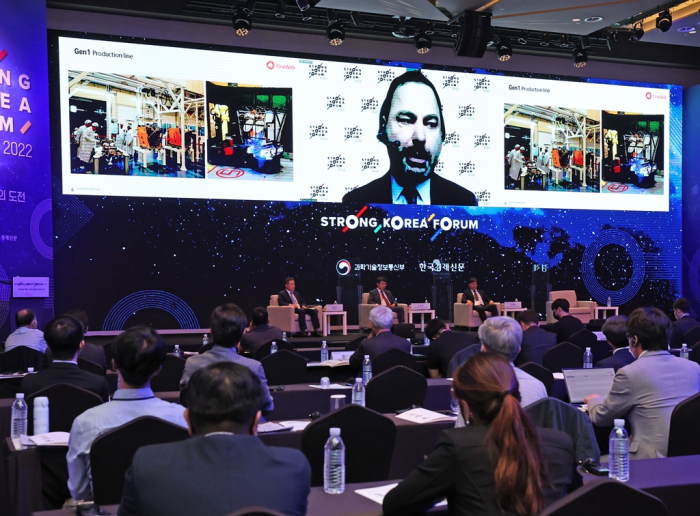Aerospace & Defense
UK satellite firm OneWeb to provide services in Korea
OneWeb will be able to provide backhaul to 5G cell sites in remote areas – CTO Massimiliano Ladovaz
By May 30, 2022 (Gmt+09:00)
long read
Most Read
LG Chem to sell water filter business to Glenwood PE for $692 million


KT&G eyes overseas M&A after rejecting activist fund's offer


Kyobo Life poised to buy Japan’s SBI Group-owned savings bank


StockX in merger talks with Naver’s online reseller Kream


Meritz backs half of ex-manager’s $210 mn hedge fund



UK’s satellite company OneWeb plans to provide services for airlines and ships in South Korea where its geographic conditions kept the existing technology from meeting demand from those clients.
The low Earth orbit satellite communications firm is already delivering high-speed, low-latency connectivity everywhere north of 50 degrees latitude, including all of the UK with satellites it has placed in orbit, OneWeb Chief Technology Officer Massimiliano Ladovaz told The Korea Economic Daily in a written interview.
“While South Korea of course has some of the world’s most robust communications services, it also presents challenges to legacy communications technology, such as mountainous terrain and a major maritime industry, that OneWeb is perfectly poised to meet,” said Ladovaz.
“Our connectivity will extend the current coverage of terrestrial networks and be able to provide backhaul to 5G cell sites in remote areas where it’s not economically feasible to deploy fiber. OneWeb will also provide Aero-Maritime services to Korean airlines and ships.”
OneWeb last year secured $300 million from Hanwha Systems Co., the defense and air mobility unit of South Korea’s Hanwha Group, which is trying to expand its presence in the growing commercial space market.
Ladovaz had the interview last week for the STRONG (Science, Technology, and Research are Our National Goal) Korea Forum that The Korea Economic Daily, a leading newspaper, and the Ministry of Science and ICT have been holding for a decade.
Global corporate and academic leaders of major science and technology industries discuss measures to develop technologies further in the annual event.

The following is an excerpt from the interview with Ladovaz.
▲ How many satellites have you launched and are you managing as the first generation, and how many do you expect to launch as the next generation? They are currently focused on communications; what about OneWeb’s plan of developing navigation satellites?
To date, we have launched 428 Low Earth Orbit (LEO) satellites, almost 70% of our planned first first-generation network of 648 satellites. Our constellation once complete will deliver high-speed, low-latency connectivity worldwide. With the satellites we have now placed in orbit, we are already able to deliver connectivity everywhere north of 50 degrees latitude, including all of the UK.
OneWeb is already in discussions with partners regarding our second-generation constellation. We can’t share details yet on numbers or specific services, but suffice to say we anticipate Gen 2 underpinning a robust offering that will bring even greater connectivity capabilities, including more capacity and positioning, navigation, and timing (PNT) services.
▲ The global broadband satellite internet services of OneWeb seem to be imminent. Please tell us the detailed plans and timelines of the launch and service. What about the revenue?
OneWeb’s vision is to deliver impactful connectivity to people by land, sea, and air. With almost 70% of our network launched and our satellites orbiting in a polar orbit from north to south, we are able to deliver connectivity first and foremost to areas above the 50th parallel. This includes - across the whole of the UK, Canada, Alaska, Norway, and the wider Arctic circle above 50 degrees latitude. We are committed to delivering a global service and look forward to our next launches which will enable us to continue our progress.
On launches, we can’t share a detailed timeline at this time, but we are thrilled to have secured agreements with SpaceX and New Space India that will enable us to resume our launch program and finish deploying our full constellation.
OneWeb does not disclose detailed financial metrics such as revenue. However, OneWeb is fully funded and backed by a global coalition of well-respected shareholders – including the UK Government, Hanwha, Bharti Global, Hughes, Softbank, and Eutelsat.
▲ Please tell us the technical specifications of the internet service, including bandwidth, latency, download/upload speed, frequency etc. What are the OneWeb’s relative advantages or strengths in comparison to Space X’s Starlink or Amazon’s Kuiper?
OneWeb delivers an enterprise grade, 5G-ready, high-speed, low-latency service. Our business model is one where we deliver our services through distribution partners who are governments, telecommunications companies, ISP providers and the like. These companies have the deepest understanding of the connectivity gaps and are seeking to use OneWeb services to create resiliency, redundancy or to connect hard to reach areas.
As for speeds, the OneWeb network is built to deliver connectivity based on the use case – be it at sea, community wifi, enterprise, government application. Our network can deliver on average 100 Mpbs / 20 with a latency of less than 70 ms roundtrip, depending on the use case.
▲ The satellite communication (link) seems to be not ready yet—how has its progress been? Is the satellite handover stable?
We have introduced services to a number of partners and are pleased with the results. Our early partners are vital to providing feedback so we can ensure to optimize our performance and service. Again, we are happy with our first services and look forward to expanding even further.
▲ OneWeb approaches customers through each of the countries’ local telecommunication companies, whereas Starlink approaches customers directly. Please tell us the advantages of the former strategy.
We have a growing list of distribution partners including AT&T, BT and Hughes, and we firmly believe that our local partners know their respective markets best, and provide best-in-class services to end customers via the OneWeb LEO solution. The specialization our model enables is also a major plus.
▲ Many satellite services of start-ups made a great impact during the Ukraine-Russia war. Has OneWeb made any impact during such current situation with its launched satellites? The business range of the satellite service companies is expected to grow larger. Please share your opinion.
Global challenges including the COVID pandemic and the war in Ukraine have only redoubled our commitment to unleashing the potential of global connectivity solutions. People need to be connected, and we can help facilitate this like few others can.
Despite some short-term challenges related to the events in Ukraine at the start of the year, we remain confident in our road ahead. Our recent agreement with SpaceX enabled us to resume satellite launches this year, and we have continued to make significant progress toward our goals.
▲ Mr. Massimiliano Ladovaz, as CTO, you lead the R&D, design, manufacture and delivery of OneWeb’s satellites, launch program, systems, ground and user terminal engineering as well as satellite operations. In your opinion, what are the strengths of OneWeb in comparison to other competitor companies?
OneWeb has many technical advantages, but our go-to-market strategy is what really sets us apart from others in the industry. By partnering directly with local service providers and governments, our B2B approach scales our ability to reach end consumers more rapidly and effectively.
OneWeb connectivity is high-throughput, resilient, secure, low-latency innovation in broadband communications, powered from Space. We offer enterprise-grade connectivity from our broadband communications network to enable communities, governments, businesses and industries such as aviation and maritime to become connected to the cloud, applications, customers, people and devices. We partner with network operators for resilient last mile and backhaul solutions.
▲ What is the most difficult technical challenge you face for the satellite constellation service?
“Most difficult technical challenge” is a bit of a misnomer — the real challenge is to not look at any one issue individually, but rather holistically, given the nature of this industry. There are many technology innovations that need to take place in order for our industry to really progress in the near and long term. In LEO, some of the technical challenges or innovations we need to consider include inter-satellite links, PNT, resilience capabilities, extended dual-use earth observation, greater throughput and cybersecurity. Additionally, software-defined satellite upgrade capabilities and in-orbit life extension services will be critical.
▲ Does OneWeb plan any cooperation ahead with its private investor Hanwha?
As with all of OneWeb’s global shareholders, including Hanwha, we draw on their expertise and operational support. We have been immensely pleased with the technological sophistication and spirit of innovation at Hanwha. Since beginning our partnership last year, we have worked with Hanwha to explore bringing OneWeb’s LEO solution to its existing customer base.
▲ Please describe the scenario of the OneWeb introducing its service in South Korea. What advantages do you expect customers to find in the OneWeb’s service, in comparison to ground communications services?
OneWeb LEO solution can be deployed in every corner of the country. While South Korea of course has some of the world’s most robust communications services, it also presents challenges to legacy communications technology, such as mountainous terrain and major maritime industry, that OneWeb is perfectly poised to meet. Our connectivity will extend the current coverage of terrestrial networks and be able to provide backhaul to 5G cell sites in remote areas where it’s not economically feasible to deploy fiber. OneWeb will also provide Aero-Maritime services to Korean airlines and ships.
▲ OneWeb overcame the financial crisis faced in 2020; such hardship is indeed seen as inevitable for start-ups. Many specialists believe that the nucleus of the space industry should be led by start-ups since innovation and its fastness is important. Please evaluate this statement as a successful start-up.
We emerged out of Chapter 11 with our vision and pre-bankruptcy progress intact. We were able to make a comeback in record time in part thanks to the foresight and high degree of credibility of the UK Government and Bharti Global, which formed the consortium that acquired OneWeb out of Chapter 11. Supportive shareholders have since invested $2.7 billion of new equity into the business. The company is now fully funded, and benefits from earlier investments in design and technological delivery in concert with up-to-the-minute innovations that continue to this day and into the future.
Write to Hae-Sung Lee at lhs@hankyung.com
Jongwoo Cheon edited this article.
More to Read
-
 Tech, Media & TelecomHanwha-invested OneWeb’s internet satellites launched into orbit
Tech, Media & TelecomHanwha-invested OneWeb’s internet satellites launched into orbitOct 15, 2021 (Gmt+09:00)
1 Min read -
 Mergers & AcquisitionsHanwha Systems invests $300 million in UK satellite firm OneWeb
Mergers & AcquisitionsHanwha Systems invests $300 million in UK satellite firm OneWebAug 12, 2021 (Gmt+09:00)
3 Min read
Comment 0
LOG IN


